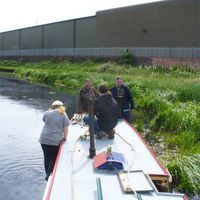

NigelMoore
Member-
Posts
4,153 -
Joined
-
Last visited
-
Days Won
26
NigelMoore last won the day on October 15 2017
NigelMoore had the most liked content!
Profile Information
-
Gender
Male
Recent Profile Visitors
12,035 profile views
NigelMoore's Achievements
Veteran (11/12)
662
Reputation
-
You are still conflating the 2 distinct elements, which only serves to confuse the relevant issues. Attachment/touching, however temporary, remains a distinct act of potential trespass depending on what relevant rights either public or private attend the situation. US case law in this area is more comprehensive than here in the UK, but even so, the extent of permissible temporary (even accidental) contact with land over which one may legitmately float, has been the subject of judicial examination over centuries. A land owner may grant a right of 'occupation' that still requires an extra right enabling a less transient occupation. Where a boat can be kept stationary by means of attachment to the ripa rather than to a 3rd party's fundus, then the elements are satisfied - but the fundus owner in granting an occupation right over the fundus is not thereby obligated to also grant an attachment right to enable mooring TO the fundus in the absence of an adjacent riparian owner's consent. So far as I can see in this particular decision, the judge has been very careful to keep the distinct elements separate. It very specifically does.
-
Hardly. If you were not under way, then absent some attachment to land (whether fundus or ripa) you would be drifting out of contol contrary to byelaws. Any mooring right comprises 2 essential elements: a right to float on the water, and a right to attach to a fixed point of land. The boat licence allows only one element, the gift of the other lies with the appropriate land owner.
-
Yes, that is exactly what I am suggesting, because it uses the very language relied upon by CaRT when claiming what is NOT being granted by the boat licence. Of course, although I believe that the outcome was the right decision to have made in the strict terms of this appeal, my views on the entirely false argumentative construct of the nature of licences would necessitate a rejection of any conclusion based thereon - but that is hardly open to CaRT; the judge has made his decision based solely on how THEY represent "the contract".
-
I first read through this judgment in some dismay at the unquestioning swallowing of the Boat Licence “contractual” nature, alert to any knock-on effects in relation to other current issues plaguing yet another sector of boaters, with offside moorings that CaRT refuse to recognise. The refusal of the Appeal Court to consider my marshalled arguments on that topic (in the interests of focussing on a single issue), meant that the EoG situation has remained since then, where Stoner & Co had left it at County Court levels – that the boat licence did NOT confer any right for the boat to occupy “land covered by water”, this being (on Stoner's argument) a 'right to keep' a boat on the water, rather than a 'right to use' a boat on the water, both rights having been abolished by the TA 1968. I have always maintained the nonsense of that argument, by reference to the wording of the 1976 byelaws, which provide that the PB licence confers – very specifically – the right to bring onto, let for hire, keep AND use the licensed boat on the Board's canals. The effect being that no further consent on CaRT's part is needed to avoid any trespass action simply for floating over the canal bed. Since those 'simpler' times, of course, CaRT have finessed their whole boat licensing scheme theory into the realm of contract law, instead of the truth that it is bound by the terms of the relevant statutes. This has 'allowed' them (in practical reality, however illegally) to give or withhold the licence at will; limit what the licence does and does not permit, and render it all subject to their agreement, based on the boat owner's enforced submission to an agreement to the arbitrary (and ultra vires) T&C's. Now, however, this recent judgment has – in at least ostensibly accepting and wholeheartedly endorsing the contractual nature of the boat licence – determined the effect of that to be a grant of consent to occupy the land beneath the water on which the boat floats. Further, that this applies across the board, whether on a CC 14 day basis or in a home mooring situation. The further unexpected serendipitous effect of this judgment therefore, is to hoist CaRT firmly by their own petard, and remove their long-held false rationale for giving or withholding consent for boat owners to moor to their own property. Interesting.
-
This post cannot be displayed because it is in a forum which requires at least 10 posts to view.
-
Interesting. I had a quick look at the 1977 Act and I presume it is s.23 that is relied on. Unlike the similar clause relating to BW in the Transport Act 1962, there are no saving clauses whatsoever! Charging 23. Without prejudice to any other power available to it, the Agency may demand, take and recover or waive such charges for or in connection with the use of the waterways and for any services or facilities provided by it in connection with the waterways as it thinks fit. I did note that one had to keep your use of the waterway in line with whatever category of navigation use you paid for. I find the application of the twin charging regime highly dubious - as well that the 2010 Order homogenised the legal basis for registration charges!
-
The bit that engaged my attention was this - “The fee set by the EA was, of course, much larger than the £2 registration fee which had previously been levied. However, it was also plain that the EA had moved from a scheme of making two charges – for registration and for use of the waterway to a combined and single charge which covered both.” If a boat was already currently registered under the prior scheme, what was the separate charge called, for use of the waterway? It sounds too much like a “licence” for comfort. Or could one register a boat as a ‘go-nowhere’ stationary vessel OR as a navigating vessel, i.e. the difference lay in the category of registration? That is not how it reads, so what did they call the additional charge for use of the waterways by an already registered boat?
-
Thanks for the link to that case erivers. It raises some curiosity in me as to exactly what distinction the EA had historically made between registration charges only, and a 'separate' charge for 'use of the waterway'. Certainly on the Thames a boat wanting to 'use' the waterway was required to be registered, but need not if merely 'kept' on the river - is that the sort of distinction referred to I wonder, though if so there were not separate charges. The difference more modern legislation brought was in 2010 covering the registration requirement for all EA rivers whether a boat was used or merely kept; I do not recognise the separate charges element that was supposedly unified as a matter of policy. I can't really look into this at the moment, being involved in preparing my own prosecution case, but I will be interested to learn more.
-
It was HH Judge Denyer QC in the judgment against George Ward of 20 December 2012 on the Bristol County Court :- “Other than the removal of the boat the only sanction provided for in the legislation in respect of a contravention of the Rules by a person such as the Claimant is that of a derisory fine. I think it has now reached the sum of £50. If they are not entitled to take these steps i.e. removal of the boat from the river they are in truth substantially powerless to enforce the obligations of those who use the waterways. I do not regard the ability to take debt recovery proceedings as being a sufficient alternative remedy. Aside from anything else they would face problems of enforcement. No doubt if they did obtain a money judgment the judgment debtor would seek to or could seek to pay at some derisory sum per week or per month.” He overlooked, of course, the fact that the same would apply to any County Court judgment as to costs etc, and also that the seizure of the boat even if leading to a sale could never be used to pay off the debt, because the relevant statute specifically bars that. They can only (legally) retain from the profits of a boat sale, the costs of seizing, storing and selling it. However it may be that this judge (and others) was misled into believing that BW could use possession of the seized boat as a lien on monies owed to them. This was pre-Ravenscroft after all. He was mistaken as to the level of fine which is £100 (plus, of course, costs, and nowadays ‘victim surcharges’). He was also off the mark about “problems of enforcement”. Having obtained a court order for fines and costs and charges, the collection could be left to court bailiffs, or payment could be sought for from central funds as respects costs at least. The judge also seems to be confusing pursuit of money judgments with prosecutions (pursuit of merely a money claim being a third option NOT, as the 1983 Act provides, preclusive of parallel criminal action. If the convicted boater proved evasive and in breach of a court order, then a warrant for their arrest could be issued, and once caught they could be sent to prison for contempt of court. There is nothing “derisory” about such implications as attached to the prosecution process. If this judge was correct, then the EA could be considered “powerless to enforce the obligations of those who use” - their – waterways” – and clearly, that is very far from the truth.
-
Very unlikely to forget it, myself. It made an impression.
-
The only reason BW/CaRT have ever advanced for not prosecuting under the byelaws (or the 1971 Act in the case of river registrations) is that the penalties imposable are “derisory”. One of the County Court judges when handing down judgment in an early s.8 case was in complete agreement with that argument re: the proportionality of utilising boat seizure powers. It is a salutary example of a wildly different administrative ethos. The EA ‘enjoy’ broadly similar powers to CaRT reference dealing with unregistered boats &/or boats that can be removed from their waterway. Stats are available on WhatDoTheyKnow that show the numbers of boats the EA had removed from their waterways compared with the numbers of boats prosecuted for failure to register, for roughly the period since CaRT first started up. No boats were removed from the Thames (a few were removed from other regions) even though dozens were prosecuted for registration evasion in the same period. The stats for Cart are almost a mirror image of the EA's; Not a single prosecution yet dozens of boat removals. Essentially, CaRT's avowed reason for choosing not to go the same route as the EA is that criminal convictions are insufficiently punitive for their taste. There is an unspoken reason too, though. Many things CaRT wish to control are not covered by relevant byelaws or statute, and rather than acquire the useful byelaws which they could then use to efficiently target the perceived problems, they have developed the argument that whatever they incorporate into Licence T&C's can be considered mandatory, such that breach of any of them can justify revocation of the licence, with the attendant threat of s.8 to accompany that. It is an effective way to enforce whatever rules they choose, without having to go to the bother and expense of asking government to approve them.
-
In fact, there are (I have since learned) no court fees payable in bringing a private prosecution for a criminal offence, so pursuing this route as the EA do, need involve only the cost of their employee's time - which is of course salaried anyway. There is no need at all for employment of solicitors or barristers to pursue the case if the in-house legal staff are up to scratch. If, however, professional representation was paid for - and that could be justified before the court - then it is always open to the prosecutor to apply for their costs (even if they fail to obtain a conviction), which, if the guilty party cannot pay, can be reimbursed out of Central Funds. That alone makes prosecutions more financially viable than s.8 removals.
-
You are correct; not licensing a boat when this is mandatory is a criminal offence prosecutable in the Magistrates Court by Canal and River Trust. This is so provided in the British Waterways 1976 Byelaws. CaRT could do exactly what the EA are doing if they chose to – what is more, in my view, that is precisely what they ought to be doing in place of s.8 procedures.
-
For those prepared to swallow the ‘official’ line of nonsense over needing CaRT’s chargeable consent, it might be worth pointing out that CaRT are now – since March this year – no longer applying the restriction of their consent to mooring against private land only if it has a residential dwelling on it. “Secondly, single ‘end of garden’ mooring applications will now be considered against privately-owned land, not just that which has a residential dwelling on it. Permission will only be granted to the landowner and sub-letting the mooring will not be permitted.” https://canalrivertrust.org.uk/news-and-views/news/online-mooring-policy-updated
-
Many towpaths (though not all) were recorded as public rights of way under the National Parks and Access to Countryside Act 1948, despite vigorous opposition from the British Transport Commission. BW continued to consider all towpath use as by their consent only, regardless, but there was no legal merit to that, post the publication of the Definitive Maps & Statements under the Act. It might also help understanding of the topic to note that the legal situation was altered yet again under the terms of the Transfer Order of 2012. As the ‘Explanatory Document’ to the Order states: The Trust Settlement also requires the CRT to grant free pedestrian access to the towpath (except in certain very tightly defined circumstances and again with the prior consent of the Secretary of State, following public consultation and, in the case of towpath in Wales, after consulting the Welsh Ministers). . . . Free Public Access The right to free access to towpaths for pedestrians will be enshrined in the Trust Settlement. In addition, CRT will publish a policy on access and leisure on the waterways and their towpaths. The policy will in particular set out how CRT will as a general rule ensure pedestrian access free of charge and the extent of necessary qualifications from the general rule for operational/maintenance purposes and control of access at some tourist sites. It will also deal with the promotion of cycling and partnerships to improve the cycling environment. https://www.legislation.gov.uk/ukdsi/2012/9780111521045/pdfs/ukdsiem_9780111521045_en.pdf








